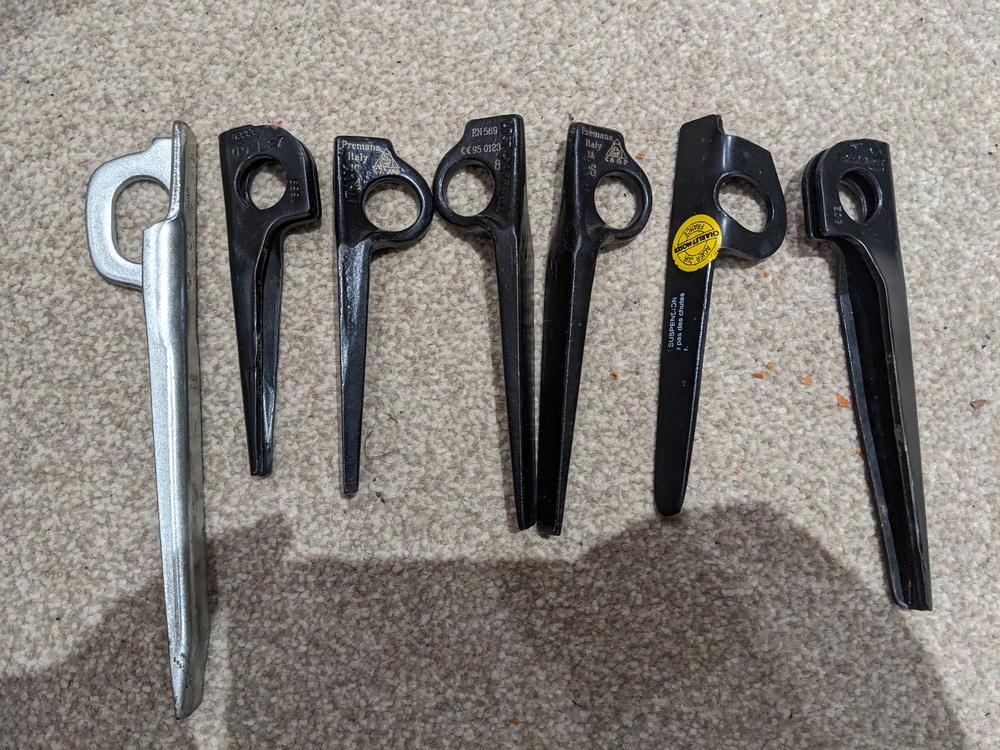Passive piton placements
|
|
What's the deal? They seem to not be talked about much but a common technique in the valley. What sizes should I go for if I'm building a passive piton rack? |
|
|
My vote for best non-hammered piton: #3 beak Second choice would be a #2 beak |
|
|
John Shultz wrote: Apart from the obvious that is beaks, they're hand placed so often they're quite literally hooks. |
|
|
Older topos speak of hand-placing sawed-off angles, but beaks often slide right into the bottom of those same scars. |
|
|
Bongs are great pieces! |
|
|
I hand placed my #6 LA and longer angle on the traversing pitches of zodiac. Maybe could have fit a giant hook or some funky piece, but these were easy and bomber. |
|
|
Any suggestions on sizes for passive angle pitons? Are they generally larger? |
|
|
I think i also handplaced a long LA on Zodiac. Devils Brow or maybe above the Nipple. I also found a stubby sawed angle useful twice on The Shield. Some of those boxed out scars that have 2 distinct ‘ruts’ from angles will take sawed offs well. |
|
|
A place where pitons sometimes get used is when getting onto a small ledge (and you're not skilled enough to mantle onto it). At the point the ledge meets the vertical wall above, there's often a very narrow slot between. It's often pretty awkward to get a cam to hold, tricams can work well, but for narrow slots a hand placed piton can be the most bomber option. Lost arrows or knifeblades are good. Often a beak works too (and is more likely to be on hand), either buried full depth upside down or sideways with just the blade part in the slot, loading outwards on the lower hole (so the beak blade gets torqued in the slot, similar to how a cam hook holds). |
|
|
So I managed an ebay bulk purchase on some pitons, I've ordered them left to right in order of least to most useful. The little angle I see almost no use for and the giant silver one maybe for some weird super deep scare but otherwise it's a wind-chime. What do you think? What else do I need? Am I wrong about the order? |
|
|
my opinion on most useful to least useful for granite aid - shortest lost arrow, other two lost arrows, knifeblade, small angle, big angle, silver pin. That is my order for hammering. I haven't handplaced many pins other than beaks but I still think my order would be similar. Sawing those angle would make them more useful for popular routes |
|
|
An early 70’s Chouinard equipment catalog, in its early era of promoting clean climbing, had a blurb about how to use pitons without destroying the rock. It advocated hand placing pitons in pin scars. When weighed, they would “cunningly jam themselves in”. A Montana friend of mine, having just read that, was testing this method (aid climbing) when a hand placed piton he was standing on “cunningly” un-jammed itself and sent him flying. I don’t remember him ever trying that again. |
|
|
that guy named seb wrote: Sawed-offs for sure, but I would tap the placement gently once with my hammer to seat it. I've used all sizes from half-inch to inch-and-a-quarter, but I hardly ever use them anymore because a beak will sit in the bottom of most former sawed-off placements. |
|
|
The big angle is 135mm, how short for the sawn off? |
|
|
Hand-placed and weighted simultaneously (although the left one was good by itself): Btw before Tube Chocks were introduced (1973), I hand-placed four-inch bongs endwise in offwidths for protection. The length of a bong was about six inches, and the tip was tapered slightly, facilitating wedging into vague constrictions. A short sling went through the eye closest to the hilt, and it could vaguely make the bong cam like a Bigbro. Those were laterally unstable, so I might have been naive about how much those could hold. Some placements were better than others and were more often merely good enough for aid. |
|
|
Did some aid today and I found the fat silver to actually be incredibly useful in old big angle placements, a totem wouldn't work but I suspect a tricam would have worked wonders. |
|
|
that guy named seb wrote: yea, it depends on the route and it's time and place in history. ie You'll find plenty of angle sized hand placements on The Prow or Dihedral wall that had hundreds of ascents before cams. You had to nail damn near everything. Beaks often go in the base of the same hole essentially hooking the placement but wedging in the original thin crack. |

 Continue with onX Maps
Continue with onX Maps Sign in with Facebook
Sign in with Facebook






















